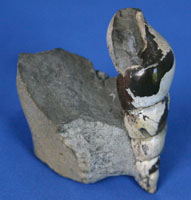The Class Gastropoda belongs to the Phylum Mollusca. Gastrpopds, or snails, may be marine (salt water), fresh water, or terrestrial (land dwelling) mollusks that have a well developed head with tentacles, eyes and a mouth equipped with a file-like tongue or radula. At its base the animal is provided with a muscular foot which can be expanded and contracted to allow for mobility. Generally, the internal organs are protected by an external calcarious shell which is secreted by the mantel. The shell may be conical or saucer-shaped and is usually coiled into a spiral. The shell may be a right-handed or left-handed coil (uncommon) which enlarges as the animal grows.
The shells grow as accretions of shell matter are secreted by the mantle and added to the edge of the opening. As the shell grows, features are added to the whorls (coils of the shell), like: folds, ribs, rows of nodes or spines, that may be closely or widely spaced. Whorls may be broad or narrow. There may be a notch in the whorl. Some whorls may be robust, others flat. The whorls and shell features are used to indicate the Family, Genus, and Species of the animal.
Many of the fossils from South Dakota will fluoresce due to the replacement of the shell and bone by calcite and chalcedony. Both photos of this specimen were taken under short wave fluorescent light. The yellow fluorescent mineral is calcite. Any green fluorescence would be chalcedony and any purple is due to the UV lights reflecting off the light colored non-fluorescing minerals in the specimen. Also check out other South Dakota fluorescent offerings under the Fluorescents section. Then click on the "To view specimen material from South Dakota" link. Some normal light photos will be shown there as well. This specimen may be seen in the fluorescent section under the same item number followed by an "F."
This specimen has not been identified.
Gastropod 
Quantity in Basket: None
Code: SDG-101
Price: $30.00
Shipping Weight: 0.47 pounds
Time: Upper Campanian Stage of the Upper Cretaceous, approximately 73-72 million years ago.
Location: South Dakota, USA
Dimensions: 2-1/8" x 1-5/8" x 2-3/8"